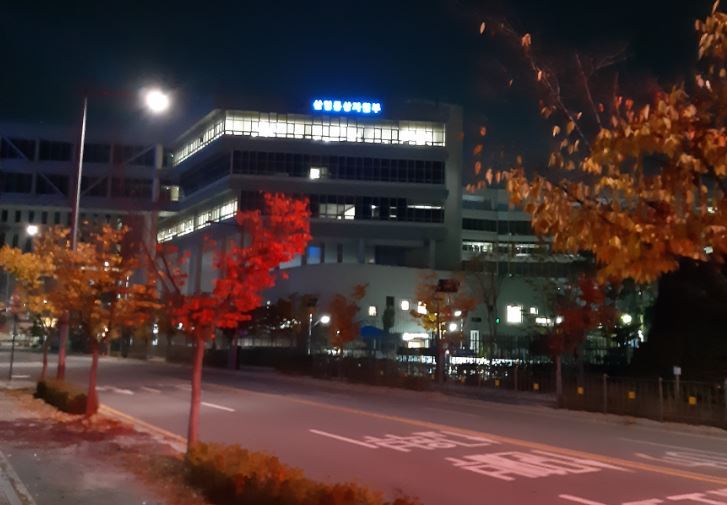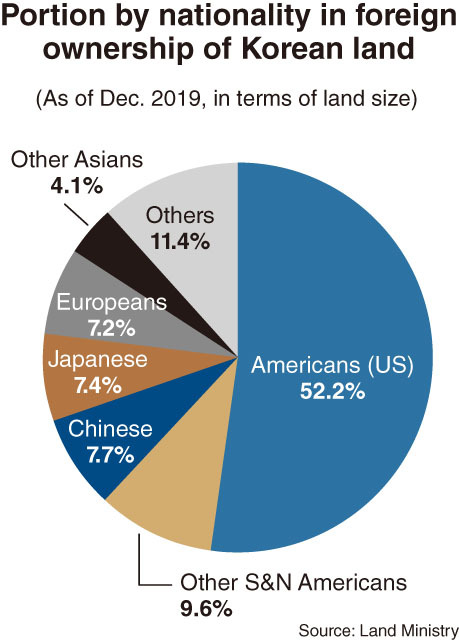[News Focus] Of all foreign-owned land in Korea, Americans own 52%
By Kim Yon-sePublished : Nov. 26, 2020 - 17:17

SEJONG -- Foreign ownership of South Korean land has continued to increase over the past few years, data from the Ministry of Land, Infrastructure and Transport showed.
As of December 2019 foreigners owned 248.6 million square meters of land, or 248.6 square kilometers, which is the latest figure available. This was a 3 percent increase from a year earlier in terms of land owned, as opposed to the value of the real estate.
Compared with December 2016, when the figure was 233.5 million square meters, it represented 6.4 percent growth.
The Land Ministry specified that the foreigners comprised individuals, corporations and public organizations. Ethnic Koreans were counted among the foreign individuals.
As of December 2019 foreigners owned 248.6 million square meters of land, or 248.6 square kilometers, which is the latest figure available. This was a 3 percent increase from a year earlier in terms of land owned, as opposed to the value of the real estate.
Compared with December 2016, when the figure was 233.5 million square meters, it represented 6.4 percent growth.
The Land Ministry specified that the foreigners comprised individuals, corporations and public organizations. Ethnic Koreans were counted among the foreign individuals.

Real estate investors from the US held the largest proportion of foreign-owned land last year, 129.8 million square meters or 52.2 percent of the total. Of the land owned by US citizens, Korean Americans owned 95.9 million square meters.
Nationals of other countries in the Americas, such as Canada, Mexico, Brazil and Argentina, collectively owned 9.6 percent of the total or 24 million square meters.
Investors from China held 7.7 percent of all foreign-owned land, or 19.3 million square meters. According to a variety of real estate agency sources, Chinese nationals are active buyers of apartments in Seoul’s wealthy Gangnam and Seocho districts, having shifted their focus to Seoul from Jeju Island.
Chinese investors aggressively purchased properties on the island over the past decade. Unlike Koreans, they are not subject to the country’s strict credit-based lending and mortgage rules.
Japanese were next with 7.4 percent of all foreign-owned land, or 18.5 million square meters. Europeans owned 18 million square meters, or 7.2 percent, and those from other Asian countries accounted for 4.1 percent of foreign ownership with 10.3 million square meters.
Investors from other regions of the globe collectively owned 28.5 square meters, or 11.4 percent of the total.
Likewise, data from the National Tax Service showed that purchases of local apartments by foreigners have increased in recent years. The number climbed from 5,308 apartment units in 2017 to 6,479 units in 2018 and 7,371 units in 2019. Of the 23,219 foreign individuals who bought 23,167 apartment units between January 2017 and May 2020, 13,573 individuals or 58.4 percent were Chinese.
Some Koreans are calling on the National Assembly to enact laws restricting foreign ownership of local real estate, saying it plays a part in inflating apartment prices.
They question whether the government has any means of imposing heavy property taxes on non-Koreans who own multiple homes, though Korean nationals are subject to a tough taxation for owning multiple homes.
The anxiety stems from the failure of the Moon Jae-in administration’s real estate policies, despite repeated promises that those policies would curb housing prices.
According to the Land Ministry, an 85-square-meter unit in the Banpo Hill State apartment complex in Seocho-gu, Seoul, cost between 1.2 billion won ($1.08 million) and 1.4 billion won in 2015. But those prices ranged between 2.2 billion and 2.7 billion won in 2020.
Additionally, inflation has worsened over the past year in some areas involving the nation’s administrative city of Sejong.
In Sejong’s Dodam-dong, a 100-square-meter unit in the Hanlim Full-Ever complex went for between 528 million and 790 million won in 2019. Those traded between 700 million and 1.28 billion won in 2020.
By Kim Yon-se (kys@heraldcorp.com)







![[KH Explains] How should Korea adjust its trade defenses against Chinese EVs?](http://res.heraldm.com/phpwas/restmb_idxmake.php?idx=644&simg=/content/image/2024/04/15/20240415050562_0.jpg&u=20240415144419)











![[Today’s K-pop] Stray Kids to return soon: report](http://res.heraldm.com/phpwas/restmb_idxmake.php?idx=642&simg=/content/image/2024/04/16/20240416050713_0.jpg&u=)